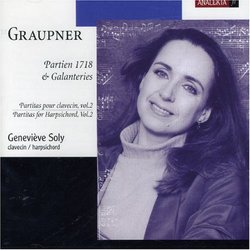| All Artists: Christoph Graupner, Geneviève Soly Title: Graupner: Partitas for Harpsichord, Vol. 2 Members Wishing: 1 Total Copies: 0 Label: Analekta Original Release Date: 1/1/2003 Re-Release Date: 4/3/2007 Album Type: Import Genre: Classical Styles: Opera & Classical Vocal, Chamber Music, Historical Periods, Baroque (c.1600-1750), Classical (c.1770-1830) Number of Discs: 1 SwapaCD Credits: 1 UPC: 774204316426 |
Search - Christoph Graupner, Geneviève Soly :: Graupner: Partitas for Harpsichord, Vol. 2
 | Christoph Graupner, Geneviève Soly Graupner: Partitas for Harpsichord, Vol. 2 Genre: Classical
|
Larger Image |
CD Details |
CD ReviewsStartling Discovery of First-Rate Baroque Harpsichord Music J Scott Morrison | Middlebury VT, USA | 09/30/2003 (5 out of 5 stars) "The story of how the music on this disc and its immediate predecessor came to be recorded is one of some musicological excitement. Geneviève Soly, a harpsichordist from Montréal, took a year off from performing and went nosing around music libraries looking for music to play. At the Yale University library she found an old collection of eight partitas for harpsichord by Christoph Graupner (1683-1760) that had been published from manuscript in Darmstadt in 1918 and then promptly forgotten about. It happens that Graupner was so modest that he never allowed a portrait to be made and turned down the job that Bach eventually got in Leipzig because his then-employer, the Landgrave of Hesse-Darmstadt asked him to do so; he spent the rest of his life in that job. He also instructed his family to burn his voluminous manuscripts upon his death but the City of Darmstadt, where he had been court composer for over fifty years, challenged this in the courts and, after a legal battle of almost 60 years, they won the rights to the manuscripts which have been preserved there. A small publication of Graupner works was made in the early 1900s but didn't attract much attention. And otherwise he was pretty well unknown in modern times. This recording , Volume II of a projected series that will comprise all these partitas, is a world première of what, I believe, is world-class music. [I am indebted to Barry Brenesal, who interviewed Ms. Soly for Fanfare recently, for much of this information.]Clearly, as with his generation of composers--Bach, Handel, Telemann and Scarlatti; what a generations THAT was!--he was aware of stylistic trends throughout Europe. Indeed, if I had not known the provenance of these pieces I would have thought they were written by a French composer. Unlike the music that Bach or Handel wrote 'in the French style' (e.g. Bach's French Suites) where the French approach was grafted onto German procedures, Graupner's music 'sounds' French through and through. On this disc we have Partita No. 2 in C minor and No. 8 in F major, as well as excerpts from a couple of other partitas. The various movements are give French titles. [Interestingly, Graupner's assimilation of French musical styles didn't extend to a grasp of the French language; he consistently misspells 'gigue' as 'gique,' and 'rigaudon' as 'rigoudon.' He also calls a sarabande a 'sarabante.' No matter, it's the music that counts.]Like French music of the period there is much less use of strict counterpoint as in German music--although the 'gique' of the 8th partita is a terrific fugue--and consistent use of French dance forms. The Sarabande of Partita 8 is followed by four variations--shades of Handel's 'Harmonious Blacksmith'!--the last of which is a study in arpeggios. The melodic materials in these partitas is absolutely first-rate; there's not a dog among 'em. I kept going back to delicate Air of Partita 8, to the mournful Allemande of Partita 2 and the following Courante and Sarabante. The Gavotte en Rondeaux (band 19, one of the excerpted dances) is particularly choice. The gigue in C major (another of the excerpted dances) is virtuosic in the extreme and neatly played. Ms Soly's playing is superlative. Since this is a collection of dance pieces it is important to note that her handling of the various rhythms is crisp and invigorating. A word must also be said about the harpsichord on which she is playing. There is a full-color picture of it on the back cover of the booklet and it is visually a real work of art, with delicate leaves and flowers, as well as a pastoral scene, painted on the soundboards (yes, there are two sound boards with a separate one for the 16' strings). The five-octave instrument, a modern (2002) copy by Hubbard and Broekman of a ca. 1730 double manual harpsichord by H. A. Haas, has a very pleasing and deeply rich tone and includes a variety of hand-stops (including a marvelous 'nasale') that allow a good deal of tonal variety. The recorded sound provided by Analekta is a model of clarity; there is little of the clangor so often heard in harpsichord recordings. A wonderful recording of a wonderful performance of wonderful newly-discovered music. Heartiest recommendation.TT=59:38Scott Morrison"
|

 Track Listings (4) - Disc #1
Track Listings (4) - Disc #1